Processing: Sensory + Cognitive
Words to know for chapter 6:
Process - how your brain uses information
Compensate - using a strength to make up for a weakness
Storage - putting something away for safe keeping
Retrieval - getting something out of storage
Sensory - using your senses (sight, hearing, touch, smell, taste)
Cognitive - using your brain
Sequencing - putting details in order
Rational - piece by piece
Conceptual - understanding concepts and deep meaning
Holistic - looking at the 'whole thing' instead of the parts
Inferential - using your mind to 'fill in' missing information
Channel - a path used for information to travel
Modality - a method used for processing information
Sensory + Cognitive = Perfect Partnership
 Important!!Every task that you do requires a
combination of sensory and cognitive processing. Remember, all
information first enters the brain through at lease one of your
senses, then goes on to the cognitive processing areas for
understanding and storage. So both types of processing are used.
Important!!Every task that you do requires a
combination of sensory and cognitive processing. Remember, all
information first enters the brain through at lease one of your
senses, then goes on to the cognitive processing areas for
understanding and storage. So both types of processing are used.
For example, if you look up a phone number in the telephone book you first use visual processing to get the information into your brain, then sequential processing to remember the order of the specific numbers.
So, if you have a problem with this task, it could be caused by either visual processing weakness or sequential processing weakness.
On the other hand, if you have trouble remembering numbers that someone says to you, that problem could be caused by either auditory or sequential weakness.
Here's another example. Pretend you have just witnessed a bank robbery.
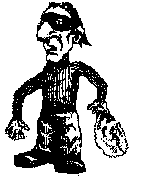
Let's list the different things you might have 'witnessed' along with the type of processing you would have used:
| What you witnessed |
Processing Used |
|---|---|
A man running |
visual + conceptual |
wearing green sweater |
visual + sequential |
and a mask |
visual + sequential |
He was short and thin |
visual + conceptual |
He said, 'out of my way!' |
auditory + sequential |
He had a gruff voice |
auditory + conceptual |
Sounded like he was limping |
auditory + conceptual |
Looks like your 'witnessing' helped to capture this dangerouscriminal.
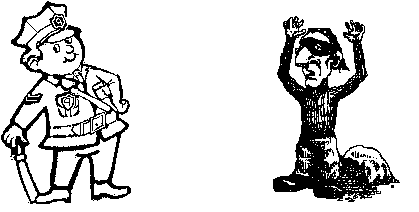
You can see from this example that specific observations involve 'sequential' processing but general observations are more 'conceptual'.
As these examples demonstrate, you actually use several different processing areas for most tasks.
The overlap between processing areas may make it seem that you experience difficulty in several areas. That's ok. What we are looking for is the one area that causes you the most difficulty most of the time.
The overlapping relationships between the sensory and cognitive processing modalities is shown below:
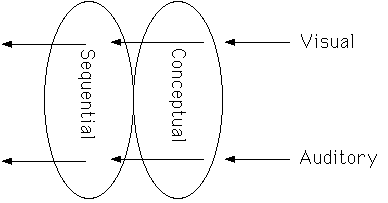
Important clue!! If you have a weakness in one channel or modality, the others modalities become 'strengths' that you can use to 'compensate'. For example, if Auditory processing is a weakness, Visual processing is probably a pretty good strength. And if Sequential processing is a weakness, Conceptual processing is probably a strength. This relationship will become very important when we explore ways of making learning easier for you.

'So, we have discovered that the main areas of information processing disability include':
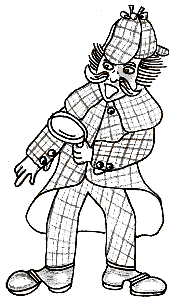
Visual
Auditory
Sequential
Conceptual
Processing speed
'And we have learned that every learning task requires a combination of at least one area of sensory processing and one area of cognitive processing. Some tasks actually required several different types of processing at the same time!'
'Have we uncovered your area of greatest processing difficulty?'
Most LD students will recognize one of the 5 processing areas discussed in this chapter as their biggest problem.
Once in a while an LD student will have a very specific processing weakness that does not fall into one of the areas covered in this chapter. If this is the case for you, please consult your casemanager or school psychologist to find out more about your processing style.
What about Haptic Processing?
Many LD specialists refer to haptic processing as being very important for LD students. Haptic processing involves learning through touch, feel, and movement. And indeed, many LD students are able to learn very well through their 'haptic' channel. But haptic processing is not really a separate processing area but is actually a combination of the sense of touch and the conceptual/holistic processing modality. In other words, a student with strong conceptual/holistic processing and a good sense of touch will learn very well 'haptically'. But, since very little 'haptic' information is available in school, haptic processing is not considered an area of disability. But you certainly may be a very good 'haptic learner'.
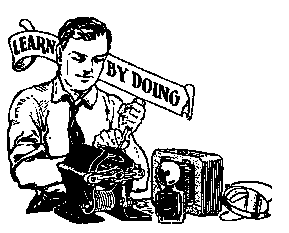
'Well, detectives. Since processing is the 'key' to this mystery, then it would seem that the mystery has been solved! Right?'
'Wrong! I have 'peeked' ahead (as any good detective would) and found many more pages to explore. There must still be more to this exciting mystery!'
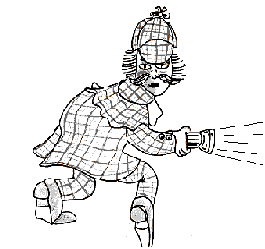
'Let's continue, shall we?'
Review Questions:
1. Why does every task you do require at least 2 forms of processing?
2. True or False: All LD students have a weakness in at least 2 areas of processing.
3. What combination of processing areas is required to learn a list of spelling words?
4. What combination of processing areas is required to paint a beautiful picture?
5. What combination of processing areas is required to remember a phone number that someone tells you?
6. If visual processing is a weakness for you, what form of processing is probably a strength?
7. What is 'haptic' processing?
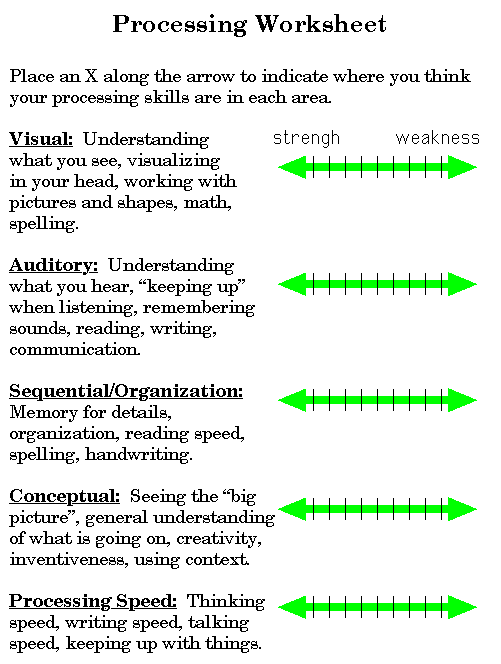
Return to the LDinfo Web Site to find out about any of the following topics (and more):
Learning disabilities - what is a learning disability (LD or SLD)?
Dyslexia: Dyslexia is a reading disability or reading disorder
Dysgraphia Dysgraphia is a writing disability or disorder
Dyscalculia Dyscalculia is a math disability or disorder
What is an attention deficit disorder (ADD, AD/HD, ADHD)?
Gifted LD: Can a student be gifted and LD?
Emotional/Behavioral issues and LD: Do LD students experience behavior problems or depression?
Section 504: What is a Section 504 plan?
What is special education?
What is processing?
What is a severe discrepancy?
What is a nonverbal learning disability (nonverbal LD or NLD)?
What is a central auditory processing disorder (CAPD)?
Uncovering the Mysteries of your Learning Disability
Order printed copies of this manual
- Chapter 1 - What is a Learning Disability?
- Chapter 2 - What Causes Learning Disabilities?
- Chapter 3 - Discrepancy = Underachievement
- Chapter 4 - Processing: The Sensory Channels
- Chapter 5 - Processing: The Cognitive Channels
- Chapter 6 - Processing: Sensory + Cognitive
- Chapter 7 - LD Jargon
- Chapter 8 - Using Accommodations
- Chapter 9 - Other Issues Related to LD
- Chapter 10 - Intelligence vs IQ
- Chapter 11 - Exercizing Your Weakness
- Chapter 12 - LD and the Law
- Chapter 13 - Becomming an Effective Self-Advocate
- Chapter 14 - Planning for Your Future
- Chapter 15 - The Summary
Copyright © 2006-2017 LDinfo Publishing
All rights reserved. Any reuse or republishing of the text
or images on this web site without prior written consent of
the copyright holder is prohibited.